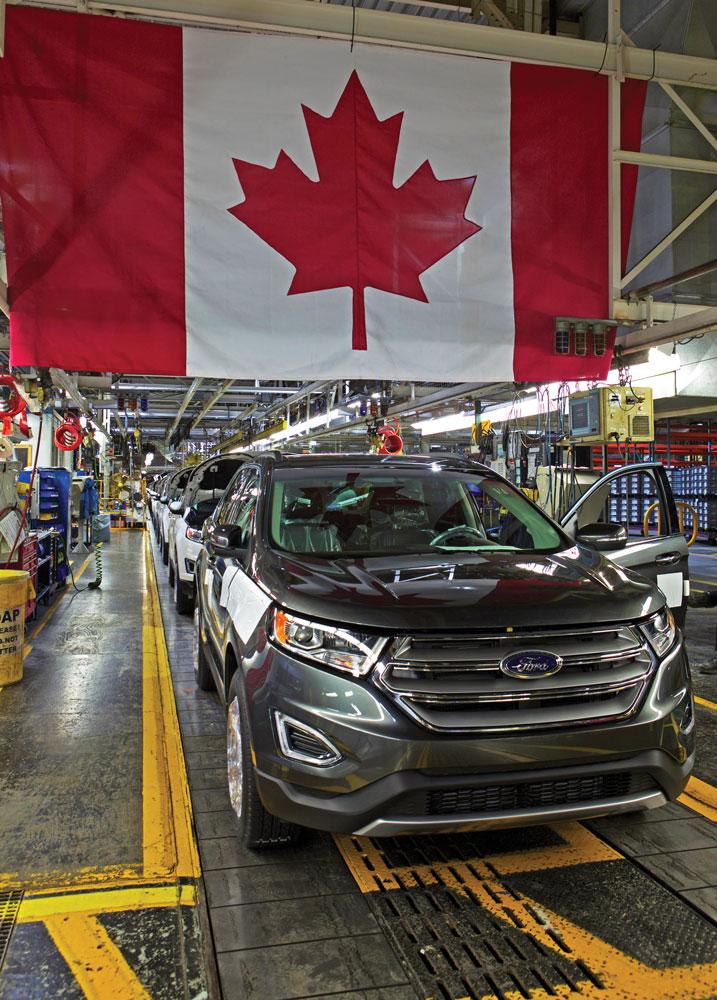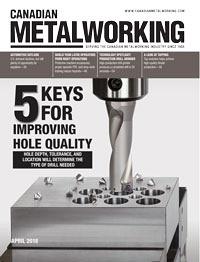- FMA
- The Fabricator
- FABTECH
- Canadian Metalworking
Automotive outlook: Look local and global
U.S. demand declines, but still plenty of opportunity for suppliers
- By Nate Hendley
- May 10, 2018
- Article
- Metalworking

The Ford Edge, shown here in current production, will be redesigned and assembled at the Oakville, Ont., facility. Photo courtesy of The Ford Motor Co. of Canada.
In January The Conference Board of Canada released a report suggesting Canadian vehicle production would increase marginally this year by 0.8 per cent. This would actually be an improvement, given production declined to 2.199 million vehicles in 2017 from 2.37 million the previous year, according to Ward’s Automotive Reports. That said, it’s still not a very optimistic forecast.
The production plateau is a result of lower demand south of the border. The Conference Board predicts that American vehicle sales will drop by 1.5 million units in 2018, caused, in part, by the popularity of ride sharing and the fact that millennials and aging baby boomers aren’t buying many cars. The report forecasts annual U.S. light-vehicle sales will be around the 16 million mark for the next five years (down from a record of almost 17.5 million in 2016).
On top of decreased U.S. demand, Canada’s vehicle sector faces additional challenges, including potential tariffs and trade disputes, as well as steep electricity prices and new minimum wage and labour laws in the automotive epicenter of Ontario.
For all that, industry experts say the sector is strong, with plenty of opportunity for suppliers, especially for firms that embrace a global outlook, high-tech solutions, and new automotive developments.
“We’re actually talking about the industry being at or near all-time record levels. If we’re going to flatten out, this is not a bad level to flatten out at,” said Dr. Tony Faria, director of the Office of Automotive and Vehicle Research at the Odette School of Business, University of Windsor.
Although Canadian production slid last year, revenues and personnel remain at high levels. Auto part shipments came to over $32 billion in 2017, according to the Automotive Parts Manufacturers’ Association (APMA), and the sector still employs more than 96,000 Canadians.
What concerns Faria more than flat production is the dearth of new vehicle assembly plants.
“The last assembly plant built in Canada was the Toyota plant built in Woodstock, Ont., [10 years ago]. Since that time 18 more assembly plants have been built in North America: 11 in Mexico, seven in the U.S. That is a concern,” said Faria.
Holding on to what we have is also an issue.
“We had 14 assembly plants in Canada in 2000. We’ve lost four since then, and now have only 10,” he added.
Shop level reaction
So, how should auto suppliers, particularly smaller shops that are highly vulnerable to market pressures, react to all of this?
Jonathon Azzopardi, president and CEO of Laval Intl., a mould manufacturer in Tecumseh, Ont., said that to thrive, small shops need to think big. This means adopting the market mindset, technological focus, and management methodologies of larger companies.
On the high-tech front, Azzopardi urges small firms to check out inventory management software, enterprise resource planning (ERP) systems, and 3-D shop floor visualization programs to boost efficiency and production. Machine controls; connectivity; and plant-based, internet of things (IoT) networks are other possibilities.
Additive manufacturing continues to gain ground, but not as a means to mass-produce parts for the sector.
“We see additive manufacturing/3-D printing as a support function, not a mainstream function,” said Azzopardi, who cited prototyping as a prime niche for this technology.
Embracing technology in general is a good way for the industry to move forward, said Faria.
Even if new assembly plants aren’t on the horizon, we can attract automotive investment in advanced technology.
“We are getting a lot of R&D investment in the automotive industry in Canada from both assemblers and parts makers. Big parts makers like Magna and Linamar spend billions on R&D activities,” said Faria.
New high-tech opportunities include:
- Developing advanced battery and fuel cell technology.
- Developing lighter-weight materials for better fuel efficiency.
- Reducing emissions.
- Creating connected and autonomous vehicles.
It’s important, however, to maintain a realistic perspective. For example, while electric vehicles have received much high-tech hype, there aren’t many of them on the road at present.
“Electric vehicles account for about one-half of 1 per cent of all vehicle sales in Canada, and they account for about 1 per cent of vehicle sales in the U.S.,” said Faria.
While the market share for electric vehicles is certain to grow, suppliers looking for new work should consider this sector a future possibility rather than an immediate money-maker.
Go global
Outside the high-tech realm, pundits say automotive suppliers need to broaden their geographic reach by establishing sales and satellite operations in other countries.
Laval Intl., for one, has a small manufacturing facility in Saltillo, Mexico.
“This is the way of the future. You have to have a global footprint or representation of some type in other countries,” said Azzopardi.
“Canada’s largest parts makers like Magna and Linamar, which are global companies, have continued to build new parts-making operations in countries all around the world where markets are growing. But even if you’re a smaller auto part maker, in addition to your location or a couple locations in Ontario, you can look at locations in the southern U.S. or Mexico,” echoed Faria.
This certainly makes sense from a bottom-line perspective because production in Mexico is exploding. More than 4 million vehicles were made in that country in 2017, a 13 per cent increase from the previous year, according to the Paris-based International Organization of Motor Vehicle Manufacturers.
The Canadian Association of Mold Makers runs a program that helps firms develop strategies and market plans that are global, added Azzopardi, who serves as chairman of CAMM and vice chair of the APMA.
As a final suggestion, Azzopardi said smaller shops should consider adopting workplace methodologies including lean manufacturing, kaizen, and 5S that are commonplace among larger firms.
Watch political moves
On top of market trends, Canadian auto suppliers also have been buffeted by political winds.
U.S. President Donald Trump recently announced tariffs amounting to a 25 per cent tax on imported steel and a 10 per cent levy for aluminum imports. For now, Canada and Mexico are exempt.
Despite the exemption, Flavio Volpe, president of the APMA, is not impressed.
“The trickle effect to parts and cars that cross [the] border in the buildup process means we all get punished with higher costs,” said Volpe in an APMA statement.
Trump also has suggested tying any future discussions about tariffs with ongoing NAFTA talks. This could be bad news, given Trump has repeatedly blasted NAFTA and mused about rescinding the free-trade deal.
While Faria believes a new NAFTA agreement is likely, he thinks outright repeal would be “insane.”
“I don’t think anyone in Canada, the U.S., or Mexico actually wants to see an end to NAFTA,” said Faria.
“A bad NAFTA deal will be bad for everybody,” added Azzopardi.
NAFTA was one of the factors that motivated European and Asian auto companies to set up plants in North America, said Faria. North American operations run by foreign OEMs benefit from the free flow of goods among Canada, the U.S., and Mexico. This easy cross-border access has been facilitated by NAFTA. As long as a trade war doesn’t break out, Canadian auto suppliers can continue to take advantage of this same access by maintaining business ties with plants in the U.S. and Mexico.
Closer to home, Faria fears that Ontario’s new minimum wage and labour laws, in addition to high electricity costs, pose major challenges to auto suppliers. Under new legislation, Ontario’s minimum wage will increase to $15 an hour in January 2019. This could add payroll burdens that small businesses might find tough to sustain. As a result, companies might cut back on hours or introduce more automation.
Azzopardi has no problem with the new minimum wage law but thinks it was rolled out too quickly and in a reckless fashion. He is deeply concerned, however, about the high price of electricity in Ontario.
“Hydro costs are terrible. We have great energy resources but for some reason we get charged the most,” he said.
Another piece of provincial legislation, Bill 148, might create extra paperwork and additional costs for Ontario firms, warned Faria. Passed late last year, this bill introduces new regulations for workplace scheduling, emergency leave, and vacations.
New auto program coming
In a bit of good news, the Ford Motor Co. of Canada announced in January it will be assembling the redesigned Edge SUV at its Oakville, Ont., facility this summer. This announcement comes on the heels of plans made by Ford last year to invest $1.2 billion to retool its Ontario plants and establish a research and engineering facility in the province.
Ford’s move did not surprise Faria.
“That was fully expected. Ford has been building the Edge in Oakville for a number of years, [and] given that Ford has invested in upgrades in the Oakville facility consistently through the years, and given it’s Ford’s only Canadian assembly plant, I don’t see the Edge ever leaving Canada. Ford sells a lot of vehicles in Canada. If Ford pulled assembly out of Canada, I think the backlash would cost them a lot of sales,” he said.
As for the future, Faria would like to see Ottawa put more money into the Automotive Innovation Fund (which finances R&D) and do a better job promoting the industry.
The Canadian government should “show that we’re open for business and tout the advantages we have. We have a highly educated workforce, we have more wide-open borders than the U.S. does. We can bring in well-trained, well-educated workers from around the world,” he said.
The auto sector is going to remain an important part of the economy, added Faria.
“Automotive is the single largest manufacturing exporter in all of Canada. We’ve got to really, really work hard to hold on to everything we have now,” he said.
Contributing writer Nate Hendley can be reached at nhendley@sympatico.ca.
About the Author
subscribe now


Keep up to date with the latest news, events, and technology for all things metal from our pair of monthly magazines written specifically for Canadian manufacturers!
Start Your Free Subscription- Industry Events
MME Winnipeg
- April 30, 2024
- Winnipeg, ON Canada
CTMA Economic Uncertainty: Helping You Navigate Windsor Seminar
- April 30, 2024
- Windsor, ON Canada
CTMA Economic Uncertainty: Helping You Navigate Kitchener Seminar
- May 2, 2024
- Kitchener, ON Canada
Automate 2024
- May 6 - 9, 2024
- Chicago, IL
ANCA Open House
- May 7 - 8, 2024
- Wixom, MI




















